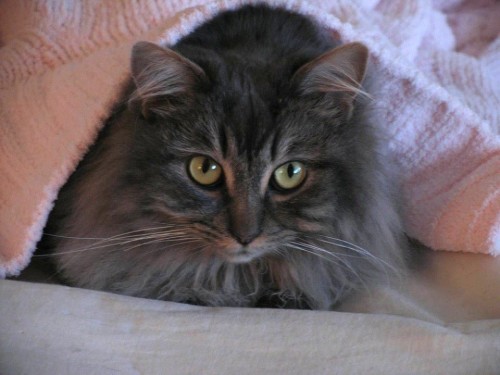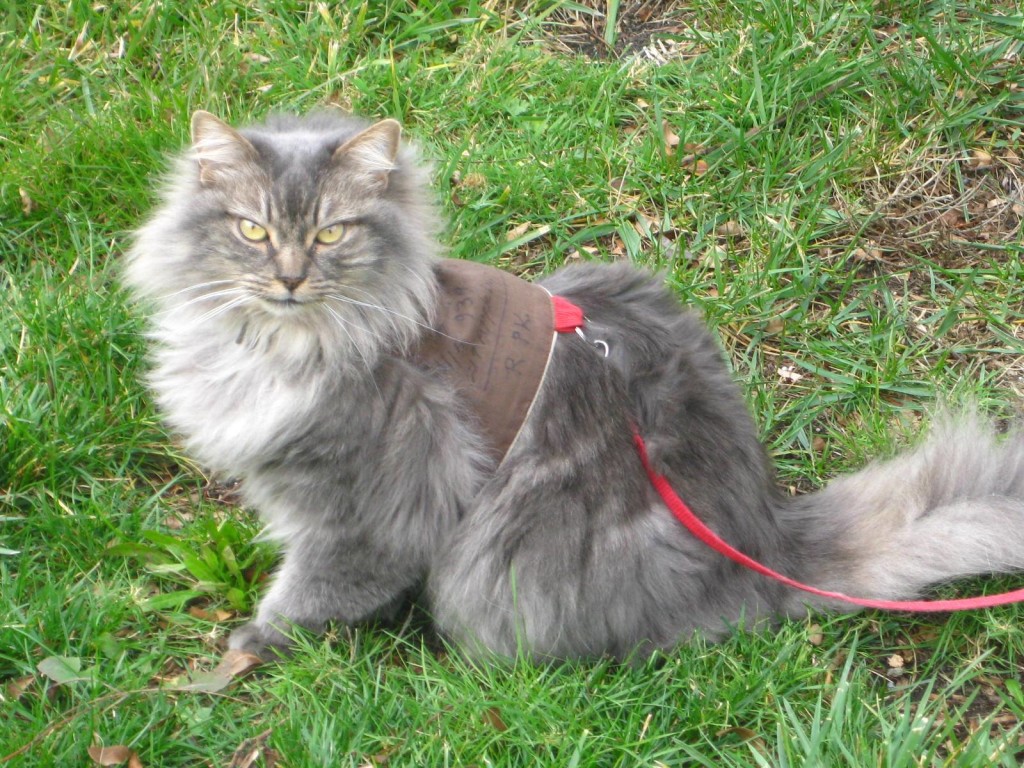My Journey to Raw: Mitzy’s Meltdown
This post is part of our “Journey to Raw” series, published on Wednesdays, and comes to you from Sandra Murphey, a semi-retired 73 yr. old entrepreneur, writer, researcher, portrait photographer for 30 years, animal lover, and advocate for cats and people. You can follow Sandra on her Facebook page, CAT Advocate!
 In Sept 2014, my adopted feral cat, Mitzy, stopped drinking the filtered water from dishes and water fountain. Her stool became harder, and there was less of it. It’s still a mystery why she stopped drinking, and I tried a variety of glass and metal containers.
In Sept 2014, my adopted feral cat, Mitzy, stopped drinking the filtered water from dishes and water fountain. Her stool became harder, and there was less of it. It’s still a mystery why she stopped drinking, and I tried a variety of glass and metal containers.
She had been eating both canned and dry food. Wellness and Fussie Cat canned, and Call of the Wild dry. I tried adding wheat bran, psyllium powder, Metamucil for fiber, but none of these worked. She didn’t eat pumpkin. I also gave her some goat yogurt, which produced a soft stool. I was excited. But then she didn’t eat it again on a regular basis.
I then tried cutting back on the dry food, and just giving her a little on top of the wet. I became concerned about her constipation issues, so I took her to the local vet, where I’d taken her when I first adopted her from the shelter five years ago. She thought she “might” have a bladder infection, (without any test) so she gave her the antibiotic Baytril and Lactulose stool softener. I’ve since learned that Baytril has caused blindness in some cats.
I had difficulty giving the pills, and brought her back in. They did blood work which was “normal”, and an x-ray which showed stool, so they gave an enema, and expressed her impacted anal glands. Sent me home with canned Hill’s WD. She ate some, but then didn’t want it anymore. I don’t blame her. YUK!
She wasn’t eating much, or eliminating, so I took her back to the vet. They kept her for a whole week, and fed her the WD, and Royal Canin High Response dry. When I picked her up, they said she was doing well, and eating the food. They pushed a large bag of the RC food, even though I said I was weaning her off of dry. I only gave her a little of this on top of wet food. She seemed addicted to it, so I returned the bag.
The following week, she ate very little, slept a lot, and had her hind legs pulled up toward her tummy. Some days she didn’t eliminate at all. I was giving Lactulose every other day.
I started her on a new product called Easy Go, mixed in with some raw ground beef and a little goat milk, which she likes. She had a good BM. I ordered this after a very long conversation with the owner of Vitality Science, a good resource for animal health issues.
She’d been sleeping longer than usual, and in a high place where I couldn’t get to her. She’d been urinating daily, but only had a stool every other day. Once she didn’t urinate for 30 hours. I’d been keeping a daily journal on her food, elimination, and sleep patterns, so I knew to the minute how long it had been.
Although I brushed her daily and used the flea comb. I noticed a lot of fur in her stools. So I got the Furminator, which is the “gold” standard, but it didn’t work very well, so I returned it, and bought the Shed Monster, which works great. I began to see less fur in her stool, but it was still hard. She liked the small amounts of raw goat milk and yogurt I was giving her, and the Lactulose stool softener was working.
 Then I noticed her scratching her ears, so much that I was seeing scabs, but I saw no evidence of mites. I took her to a different vet, and that’s when she experienced some major reactions to drugs. They found “debri” in her ears. They used Tresaderm and did a cytology, but couldn’t quite go deep enough without putting her under. So they suggested I come back the next day.
Then I noticed her scratching her ears, so much that I was seeing scabs, but I saw no evidence of mites. I took her to a different vet, and that’s when she experienced some major reactions to drugs. They found “debri” in her ears. They used Tresaderm and did a cytology, but couldn’t quite go deep enough without putting her under. So they suggested I come back the next day.
That night she wasn’t acting normal, and in the morning I noticed that she was falling over, and her pupils were different sizes. They had me bring her in, and said she was reacting to the Tresaderm. They gave her Dexdomitor/Antisedan to try to reverse the effects. They kept her most of the day. At one point, they said she might have a torn eardrum, but not from anything they did (of course). When I took her home, she was still stumbling around. So the next day we went back for Sub-Q fluids, a Cerenia injection for nausea, and Prednisolone Mini Melt. It was a full weeks before she regained her balance! After which, they told me that was a normal reaction.
I tried making my own raw food with TC Feline Pre-Mix combined with ground chicken, turkey and beef. She ate it for a while, then stopped. More research was needed, and in the meantime I was noticing some raw food recalls. Damn, was nothing safe? I gave her raw chicken, which she ate for a while.
Much of my day was spent in research on cats. Then, about 6 months ago, I discovered a local raw food manufacturer with a distribution center 20 minutes away. They even offered nutrition counseling, for a fee. I bought a one pound container of FEED THIS (strange name) turkey and sardine mix with ground bones. I had read that constipated cats shouldn’t have bones, but I thought I’d try anyway. I know bones add calcium. I defrosted the food just enough so that I could put it into serving sizes, using condiment containers at the 99 Cent Store. Then put those in the freezer.
From the first dish I put down, she ate the entire amount. She’s a small eater, so I usually start with a little more than a tablespoon. The next day, she had a beautiful poop! And she’s been doing great ever since! Yes, I consider those litter box clumps and bumps as treasures, in addition to being clues to what’s going on with her health. Since she’s been on this raw food, her coat has gotten softer and she’s actually become more affectionate. But the best part is that she doesn’t need Lactulose anymore! I haven’t given her any since she started eating raw. One of the vets told me to give her 4 doses a day, and that she’d need it for the rest of her life. So much for that advice!
She also started drinking water again from both ceramic and stainless containers. I change her water daily to make sure it’s fresh.
My Mitzy has been through a lot over those awful months, with vet visits, antibiotics, drug reactions, food changes, etc. But thanks to a fresh food diet, she has recovered and is going strong!
Sandy

If you feed a your kitties a raw menu and would like to see your story featured here, please contact me or leave a comment below!
And if you‘re interested in giving raw a try for yourself, check out our Raw Feeding and Transitioning Your Cat to Raw sections!
If you enjoyed this post or found it informative, please “Like” it, “Tweet” it, or share it using any of the buttons below. And don’t forget to check out our FB page, join the discussions in our awesome FB group and follow us on Twitter!


I have transitioned two cats to raw meat diets.
– With the first I just stopped feeding canned “cold turkey” and started feeding raw. Sure, she would not eat sometimes, but given some time she would come back and eat. Skipping a meal or two brought on enough hunger to get the cat to eat. But this one was already indoor/outdoor and sometimes capturing her own natural food which comprised less than 5% of her diet.
– With the second the transition took about 5 weeks, and getting off the dry food was the most challenging. After that I just went through steps similar to what is laid out in some website about transitioning a cat from kibble to raw.
– There are tricks. Cats like cooked meat better than raw, so I would just let a piece of meat sit for 4 – 6 minutes in a wide-mouthed thermos into which boiling water had been poured. This would cook just the outside, and cat would eat something mostly raw. Within a week the cat would eat the meat without any cooking.
– Cats LOVE rabbit. This can start out with expensive rabbit legs, then graduate to rabbit ribs as cat’s jaws become stronger and can handle bones. I feed rabbit liver at the same time as rabbit ribs.
– Cats will eat too fast and throw up. This usually does not mean that the food is wrong. It may mean that the portion needs to be larger so that the cat cannot eat fast, but must work to eat, thus allowing digestive system to prepare.
– Sometimes a cat will throw up, but re-consume, leaving a tile floor spotless. Do a search on this one and you will find it very well explained. It’s just that if a cat has thrown up it does not necessarily mean that a certain raw meat is bad for the cat. Suppose a cat in the wild encounters a meal twice what it can digest – it can cut with teeth and swallow, then go to a hiding place and regurgitate only to re-consume later when more food is needed.
– Transitioning a cat to raw and continuing raw requires attention to what is going on with the cat – there will always be puzzles to solve as to why the cat reacted to a certain food a certain way. An example would be an organic, raw chicken drumstick. Cat may take a brief sniff, then go away for awhile, and I guess develop a plan as to how to consume it. Then return 5 – 20 minutes later to consume as much of it as she can. A too-busy cat staffer/owner might well have concluded that the cat simply does not like chicken.
– Variety is supposed to be key. The cat I have now, and have been fostering since Feb 20 2016 is special needs primarily in the sense that she came to the shelter with both eyes damaged, lost one eye and needed for the other to heal up. I read this as an emergency in which the cat must go organic raw ASAP in order to maximize healing speed. She also had worms in her stools and blood at the ends of her stools. All of that cleared up within a few weeks on the raw meat diet, and the eye is healing nicely. She now eats raw: chicken, turkey, beef, rabbit, rabbit liver, goat mountain oysters, lamb heart, ground bones with organs and meat from chicken, pork.
– There is another special needs cat at the shelter I seek to foster, but cannot until I find a home for Lucy-Cat, who I believe now is ready for adoption. I feel that there is special value to a cat for whose future staffer will not have to do the dietary transitioning work, so I hope that this idea will help to get her adopted. There should be a niche of adopters who would prefer a cat transitioned to raw meat.